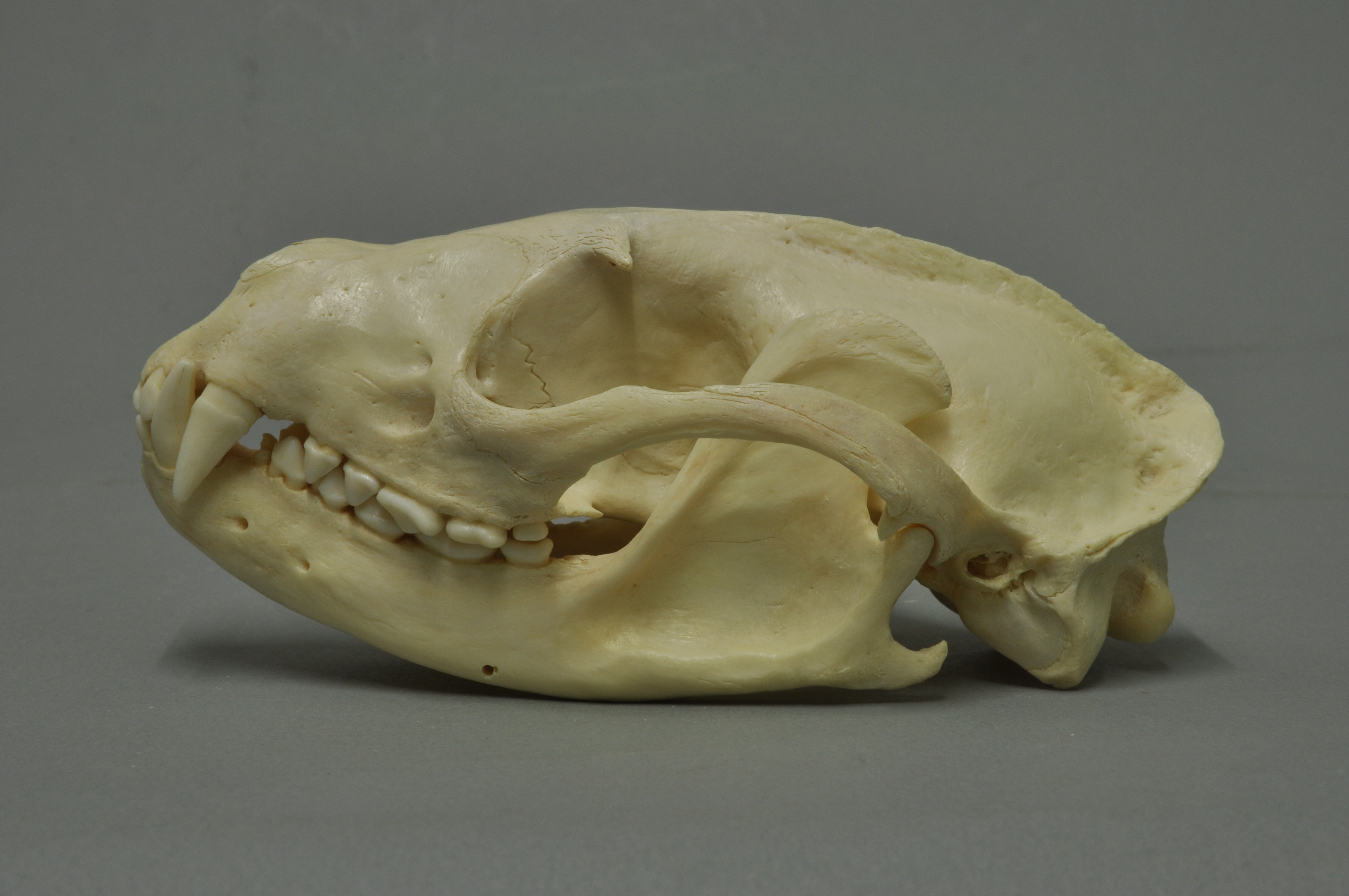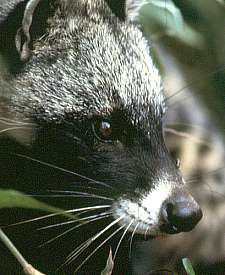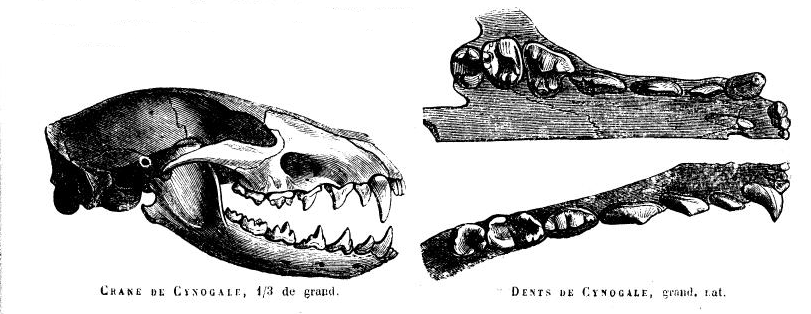|
Civets
A civet () is a small, lean, mostly nocturnal mammal native to tropical Asia and Africa, especially the tropical forests. The term civet applies to over a dozen different species, mostly from the family Viverridae. Most of the species diversity is found in southeast Asia. The best-known species is the African civet, ''Civettictis civetta'', which historically has been the main species from which a musky scent used in perfumery, also referred to as "civet", was obtained. Naming The common name is used for a variety of carnivoran mammal species, mostly of the family Viverridae. The African palm civet (''Nandinia binotata'') is genetically distinct and belongs in its own monotypic family, Nandiniidae. Civets are also called "toddycats" in English, "Mara Patti" in Malayalam, "musang" in Malay and Indonesian, and ''urulǣvā'' () in Sinhalese. There can be confusion among speakers of Malay because the indigenous word "musang" has been mistakenly applied to foxes by printed m ... [...More Info...] [...Related Items...] OR: [Wikipedia] [Google] [Baidu] |
Asian Palm Civet
The Asian palm civet (''Paradoxurus hermaphroditus''), also called common palm civet, toddy cat and musang, is a viverrid native to South and Southeast Asia. Since 2008, it is IUCN Red Listed as Least Concern as it accommodates to a broad range of habitats. It is widely distributed with large populations that in 2008 were thought unlikely to be declining. In Indonesia, it is threatened by poaching and illegal wildlife trade; buyers use it for the increasing production of kopi luwak. Characteristics The Asian palm civet's long, stocky body is covered with coarse, shaggy hair that is usually greyish in colour. It has a white mask across the forehead, a small white patch under each eye, a white spot on each side of the nostrils, and a narrow dark line between the eyes. The muzzle, ears, lower legs, and distal half of the tail are black, with three rows of black markings on the body. Its head-to-body length is about with a long unringed tail. It weighs . Its anal scent glan ... [...More Info...] [...Related Items...] OR: [Wikipedia] [Google] [Baidu] |
Macrogalidia
The Sulawesi palm civet (''Macrogalidia musschenbroekii''), also known as Sulawesi civet, musang and brown palm civet is a little-known palm civet endemic to Sulawesi. It is listed as Vulnerable on the IUCN Red List due to population decline estimated to have been more than 30% over the last three generations (suspected to be 15 years) inferred from habitat destruction and degradation. ''Macrogalidia'' is a monospecific genus. It is the only carnivoran native to Sulawesi. Characteristics The Sulawesi civet has a light brownish-chestnut coloured soft and short coat with numerous light hairs intermixed. The underparts vary from fulvous to white; the breast is rufescent. There is a pair of indistinct longitudinal stripes and some faint spots on the hinder part of the back. The whiskers are mixed brown and white. The tail is marked with alternating rings of dark and pale brown, which are indistinct on the under surface, and disappear towards the dark tip. The length of head and ... [...More Info...] [...Related Items...] OR: [Wikipedia] [Google] [Baidu] |
Paguma
The masked palm civet (''Paguma larvata''), also called the gem-faced civet, is a palm civet species native to the Indian subcontinent and Southeast Asia. It has been listed as least concern on the IUCN Red List since 2008 as it occurs in many protected areas, is tolerant to some degree of habitat modification, and widely distributed with presumed large populations that are unlikely to be declining. The genus ''Paguma'' was first named and described by John Edward Gray in 1831. All described forms are regarded as a single species. In 2003, masked palm civets at a wildlife market in China were found to have been infected with the severe acute respiratory syndrome coronavirus. Characteristics The masked palm civet's fur is grayish to ochraceous, black on the head, shoulders and neck, and blackish brown on the tail and feet. It has a white blaze on the forehead; white marks above and below the eyes extend to the ears, forming a half-collar. In morphology the masked palm civ ... [...More Info...] [...Related Items...] OR: [Wikipedia] [Google] [Baidu] |
African Civet
The African civet (''Civettictis civetta'') is a large viverrid native to sub-Saharan Africa, where it is considered common and widely distributed in woodlands and secondary forests. It is listed as Least Concern on the IUCN Red List since 2008. In some countries, it is threatened by hunting, and wild-caught individuals are kept for producing civetone for the perfume industry. The African civet is primarily nocturnal and spends the day sleeping in dense vegetation, but wakes up at sunset. It is a solitary mammal with a unique coloration: the black and white blotches covering its coarse pelage and rings on the tail are an effective cryptic pattern. The black bands surrounding its eyes closely resemble those of the raccoon. Other distinguishing features are its disproportionately large hindquarters and its erectile dorsal crest. It is an omnivorous generalist, preying on small vertebrates, invertebrates, eggs, carrion, and vegetable matter. It is one of the few carnivores capabl ... [...More Info...] [...Related Items...] OR: [Wikipedia] [Google] [Baidu] |
Carnivora
Carnivora is a Clade, monophyletic order of Placentalia, placental mammals consisting of the most recent common ancestor of all felidae, cat-like and canidae, dog-like animals, and all descendants of that ancestor. Members of this group are formally referred to as carnivorans, and have evolved to specialize in eating flesh. The order is the fifth largest order of mammals, comprising at least 279 species. Carnivorans live on every major landmass and in a variety of habitats, ranging from the cold polar regions to the hyper-arid region of the Sahara Desert to the open seas. They come in a very large array of different body plans in contrasting shapes and sizes. Carnivora can be divided into two subclades: the cat-like Feliformia and the dog-like Caniformia, which are differentiated based on the structure of their ear bones and cranial features. The feliforms include families such as the felidae, cats, the hyenas, the mongooses and the viverridae, civets. The majority of felifor ... [...More Info...] [...Related Items...] OR: [Wikipedia] [Google] [Baidu] |
Viverridae
Viverridae is a family (biology), family of small to medium-sized, feliform mammals. The viverrids () comprise 33 species placed in 14 genera. This family was named and first described by John Edward Gray in 1821. Viverrids occur all over Africa, southern Europe, and South Asia, South and Southeast Asia, across the Wallace Line. Their occurrence in Sulawesi and in some of the adjoining islands shows them to be ancient inhabitants of the Old World tropics. Characteristics Viverrids have four or five toes on each foot and half-retractile claws. They have six incisors in each jaw and Molar (tooth), molars with two tubercular grinders behind in the upper jaw, and one in the lower jaw. The tongue is rough with sharp prickles. A pouch or Anal gland, gland occurs beneath the anus, but there is no cecum. Viverrids are the most primitive of all the families of Feliformia, feliform Carnivora and clearly less specialized than the Felidae. In external characteristics, they are distinguishe ... [...More Info...] [...Related Items...] OR: [Wikipedia] [Google] [Baidu] |
Arctogalidia
The small-toothed palm civet (''Arctogalidia trivirgata''), also known as the three-striped palm civet, is a palm civet native to dense forests of Southeast Asia, from the Assam district of India to Indochina and the Malay Peninsula and on Sumatra, Bangka, Java, Borneo, and numerous small nearby islands of Indonesia. The first scientific description by John Edward Gray in 1832 was based on a zoological specimen from the Maluku Islands in the collection of the Rijksmuseum van Natuurlijke Historie in Leiden, Netherlands. It is blackish grey, has black paws and three black longitudinal stripes on the back. A monotypic genus, ''Arctogalidia'' means ‘bear-weasel’ (from ancient Greek '' arkto-'' ‘bear’ + ''galidia'' ‘little weasel’). The specific epithet ''trivirgata'' means ‘three-striped’ in Latin. The small-toothed palm civet is mid-sized by the standards of its family, weighing 2.4 kg (5.3 lbs) and measuring 53 cm (21 in) long along the body, ... [...More Info...] [...Related Items...] OR: [Wikipedia] [Google] [Baidu] |
Family (biology)
Family ( la, familia, plural ') is one of the eight major hierarchical taxonomic ranks in Linnaean taxonomy. It is classified between order and genus. A family may be divided into subfamilies, which are intermediate ranks between the ranks of family and genus. The official family names are Latin in origin; however, popular names are often used: for example, walnut trees and hickory trees belong to the family Juglandaceae, but that family is commonly referred to as the "walnut family". What belongs to a family—or if a described family should be recognized at all—are proposed and determined by practicing taxonomists. There are no hard rules for describing or recognizing a family, but in plants, they can be characterized on the basis of both vegetative and reproductive features of plant species. Taxonomists often take different positions about descriptions, and there may be no broad consensus across the scientific community for some time. The publishing of new data and opin ... [...More Info...] [...Related Items...] OR: [Wikipedia] [Google] [Baidu] |
Golden Palm Civet
The golden palm civet (''Paradoxurus zeylonensis'') is a palm civet endemic to Sri Lanka. It is listed as Vulnerable on the IUCN Red List. Its distribution is severely fragmented, and the extent and quality of its habitat in Sri Lanka's hill regions are declining. The golden palm civet was described by Peter Simon Pallas in 1778. Taxonomy ''Viverra zeylonensis'' was the scientific name proposed by Peter Simon Pallas in 1778 for a palm civet specimen from Sri Lanka. Between the 19th and early 21st centuries, several zoological specimens were described, including: *''Paradoxurus aureus'' by Frédéric Cuvier in 1822 *''Paradoxurus montanus'' by Edward Frederick Kelaart in 1852 who described a fulvous brown palm civet from the mountains of Sri Lanka, which he considered a variety of the golden palm civet. *''Paradoxurus stenocephalus'' by Colin Groves and colleagues in 2009 who described a golden brown specimen from Sri Lanka's dry zone. They proposed to regard ''P. montanus' ... [...More Info...] [...Related Items...] OR: [Wikipedia] [Google] [Baidu] |
Small Indian Civet
The small Indian civet (''Viverricula indica'') is a civet native to South and Southeast Asia. It is listed as Least Concern on the IUCN Red List because of its widespread distribution, widespread habitat use and healthy populations living in agricultural and secondary landscapes of many range states. This is the only species in genus ''Viverricula''. Characteristics The small Indian civet has a rather coarse fur that is brownish grey to pale yellowish brown, with usually several longitudinal black or brown bands on the back and longitudinal rows of spots on the sides. Usually there are five or six distinct bands on the back and four or five rows of spots on each side. Some have indistinct lines and spots, with the dorsal bands wanting. Generally there are two dark stripes from behind the ear to the shoulders, and often a third in front, crossing the throat. Its underfur is brown or grey, often grey on the upper parts of the body and brown on the lower. The grey hairs on the u ... [...More Info...] [...Related Items...] OR: [Wikipedia] [Google] [Baidu] |
Cynogale
The otter civet (''Cynogale bennettii'') is a semiaquatic viverrid native to Thailand, Malaysia, Indonesia and Brunei. It is listed as Endangered because of a serious ongoing population decline, estimated to be more than 50% over the past three generations (estimated to be 15 years), inferred from direct habitat destruction, and indirect inferred declines due to pollutants. ''Cynogale'' is a monospecific genus. Characteristics The otter civet possesses several adaptations to its habitat, including a broad mouth and webbed feet with naked soles and long claws. Its muzzle is long with numerous long whiskers. It is in many ways similar to the Hose's palm civet (''Diplogale hosei'') but has a shorter tail and no whitish underparts. Distribution and habitat Otter civets are distributed in Sumatra, Borneo and peninsular Thailand. Preferred habitat appears to be lowland primary forest, but they have also been recorded in secondary forest, bamboo and logged forest. The supposed o ... [...More Info...] [...Related Items...] OR: [Wikipedia] [Google] [Baidu] |
Sri Lanka
Sri Lanka (, ; si, ශ්රී ලංකා, Śrī Laṅkā, translit-std=ISO (); ta, இலங்கை, Ilaṅkai, translit-std=ISO ()), formerly known as Ceylon and officially the Democratic Socialist Republic of Sri Lanka, is an island country in South Asia. It lies in the Indian Ocean, southwest of the Bay of Bengal, and southeast of the Arabian Sea; it is separated from the Indian subcontinent by the Gulf of Mannar and the Palk Strait. Sri Lanka shares a maritime border with India and Maldives. Sri Jayawardenepura Kotte is its legislative capital, and Colombo is its largest city and financial centre. Sri Lanka has a population of around 22 million (2020) and is a multinational state, home to diverse cultures, languages, and ethnicities. The Sinhalese are the majority of the nation's population. The Tamils, who are a large minority group, have also played an influential role in the island's history. Other long established groups include the Moors, ... [...More Info...] [...Related Items...] OR: [Wikipedia] [Google] [Baidu] |



.jpg)



